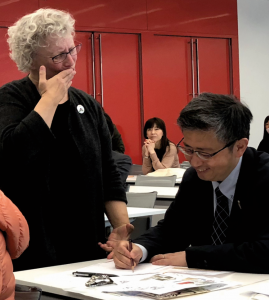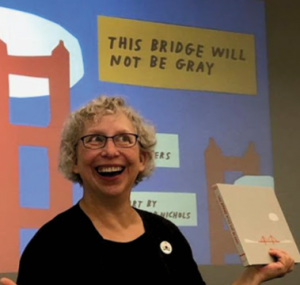Reflections
When Maloy and Edwards spoke in my library that fall day, the clouds parted for me. Their philosophy of providing materials and a nonjudgmental environment was practical and sensible—and inspirational. Over the years, I have discovered that their approach to children and writing is applicable and replicable for a broad range of ages, cultures, and abilities.
Librarians who implement a Writing Box program may find new ways to build community connections that in turn boost the program’s visibility, not only raising public awareness of their efforts but also providing an imprimatur of quality. Positive media coverage, for example, can lead to more support and attract greater enrollment, and create pride among youth participants as well.
Business and civic partners (e.g., retail stores, corporations, and service organizations such as Rotary International) can be community connections that spotlight library programs, perhaps through internal communications vehicles such as e-newsletters. Partners can also help showcase youth writing, not only sponsoring book readings in the library but, for example, also partnering with bookstores, park programming, and afterschool programs to host book readings in those spaces as well.
To recap
- Reading and writing are both essential components of a successful literacy initiative.
- Improving literacy is an essential goal of children’s and young adult library services.
- Implementing a Writing Box program is a fun, inexpensive, and proven way of achieving that goal.
- Writing can be a part of every library program with an easily replicable Writing Box program and format.
Coda
In the spring of 2018 I was asked to do a professional development workshop with teachers and librarians in Tokyo. A week before the meeting, I received an email requesting that, instead of the planned topic on archives and primary sources the organizers had requested, I change the program to speak about bridges, children’s books, and literacy. This gave me an opportunity to model how to include writing and problem solving in a read-aloud program.
What did I need? A list of books about bridges.
Three Billy Goats Gruff came to mind.
And books about building bridges. And engineering. And architecture.
And informational books about bridges.
But the real hit was this great read aloud about the Golden Gate Bridge.

Containing graphically illustrated, factually accurate text with matter-of-fact subtle humor, this title presented an opportunity to explore engineering concepts and tie in creative problem solving with activities from Iggy Peck’s Big Project Book for Amazing Architects.
The process was no different from that of a Writing Box program with children and young adults.
I provided a list of relevant titles for display, I read aloud, we did a writing activity that asked participants to create a bridge and describe its purpose, and they reflected on their work and shared their process.
The biggest surprise to me was the engagement of this group of adults, many of whom did not know each other, as they excitedly created their bridges on paper and helped each other problem solve.
As I walked around the room, I pretended to be overly concerned with one participant’s work, leaning over him with a negative body language.

I interrupted the groups’ work and through the translator spoke about how, as parents and teachers, it was important to step back and provide a nonjudgmental space.
After a few shared their in front of the whole group, I asked what they thought was the most important concept of the session.
It wasn’t the selection of literature or the modeling of writing responses or the activity. It was the permission to provide all of these things and create a nonjudgmental space for writing.

The reading/writing connection in literacy
I did not discover or invent the reading/writing connection in literacy. I was not the first to connect reading aloud with enabling children to read and write with ease and fluency.
I have benefited from The Writing Road To Reading (Romalda Bishop Spalding, revised edition 2012), Ralph Fletcher’s Joy Write: Cultivating High-Impact, Low-Stakes Writing (Heinemann, 2017) and his Writing Workshop: The Essential Guide by (Heinemann, 2011), Paper, Pen Poem: A young writer’s way to begin, by Kathy Appelt (Absey & Co 1997), Kenneth Koch’s Rose Where Did You Get That Red (Random House, 1973)…I could go on and on.
Yes, and…
That brings us back to Kids Have All the Write Stuff and how Writing Boxes began in Sharon Edward’s second-grade classroom with Robert Maloy’s insightful research into writing paralysis.
My hopes and dreams are that every librarian who serves children and young adults, parents and caregivers, teachers and professors becomes a writing mentor. That every time one of these librarians reads a book, ideas of how to incorporate writing response activities spring to mind unbidden.
I want to walk into a public library, a school library, and see grown-ups, young adults, and children reading and writing as a self-selected joyous activity.
These are my hopes and dreams.

